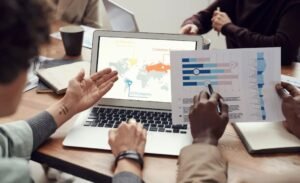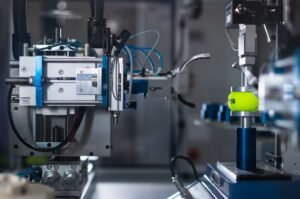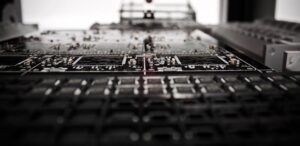When Did AI Art Start?
Artificial Intelligence (AI) art, also known as computational creativity, is a growing field where machines create original artwork using algorithms. While the concept of machines generating art may seem futuristic, the roots of this artistic movement can be traced back several decades.
Key Takeaways:
- AI art has its beginnings in the mid-20th century.
- Harold Cohen’s AARON is one of the earliest AI artists.
- Using AI in art offers new possibilities and challenges traditional notions of authorship.
In the mid-1940s, the development of electronic computers laid the groundwork for the exploration of AI art. Programs were created to generate visual and musical compositions, giving birth to algorithmic art. *These early efforts set the stage for the evolution of AI art.*
In the 1970s, Harold Cohen, a professor of visual arts, developed a program called AARON, which could generate drawings and paintings. Cohen programmed AARON to follow a set of rules and make artistic decisions autonomously. *This early AI artist demonstrated the potential power of machines in creating visual art.*
Advancements in technology and machine learning algorithms in the 1990s and early 2000s allowed AI art to evolve further. Artists began experimenting with neural networks to generate images and even trained algorithms to mimic specific visual styles such as famous artists’ works. *This marked a significant turning point for AI art, where machines could imitate and reproduce human-like artistic styles and techniques.*
The Role of AI in Art
AI has opened up new possibilities for artists and challenged traditional notions of authorship in the art world. While artists previously relied solely on their own skills and experiences, AI introduces an element of collaborative creation. Artists can harness the computational power of AI to explore new artistic territories and push the boundaries of creativity. *This collaboration between humans and machines blurs the line between technology and art.*
Table 1: Timeline of Significant Milestones in AI Art
| Year | Milestone |
|---|---|
| 1956 | First AI program capable of composing music |
| 1973 | Harold Cohen creates AARON |
| 1997 | Artificial Neural Network-based art generation demonstrated |
The integration of AI with traditional artistic processes raises questions about authorship and creativity. Should the artist be credited for the artwork created by a machine using their algorithms? *The complexities of AI art challenge the traditional attribution of creativity and artistic ownership.*
The Future of AI Art
AI art continues to evolve and intrigue both artists and audiences. As technology advances, machine learning algorithms become more sophisticated, allowing for increased realism and creativity in AI-generated art. Artists are using AI to explore new artistic expressions and elevate their creative practices. *The possibilities for AI in art are limitless and constantly expanding.*
Table 2: Pros and Cons of AI in Art
| Pros | Cons |
|---|---|
| Unlimited creative possibilities | Challenge to traditional notions of authorship |
| Exploration of new artistic territories | Dependence on algorithms |
AI-generated art has gained recognition in the art world. In 2018, an AI-generated artwork titled “Portrait of Edmond de Belamy” was sold at auction for over $432,000, highlighting the growing interest in AI art. *This sale showcased the commercial potential of AI-generated artwork.*
Conclusion
The journey of AI art began in the mid-20th century and has come a long way through technological advancements and collaboration between humans and machines. It challenges traditional notions of creativity and authorship and offers new possibilities for artists to express themselves. *The future of AI art holds endless potential for innovation and artistic exploration.*

Common Misconceptions
Misconception 1: AI art only emerged in recent years
- AI art can be traced back to the 1960s and 70s when artists like Harold Cohen and AARON created algorithmic art.
- AI art gained significant attention with the advent of deep learning techniques in the 2010s.
- Although recent advancements have led to more sophisticated AI-generated art, the concept itself has been around for decades.
Misconception 2: AI art lacks creativity and is merely a mechanical process
- AI algorithms are programmed to learn and mimic human creativity, resulting in unique and original artworks.
- Artists use AI as a tool to enhance their creative process and explore new possibilities, challenging traditional notions of authorship.
- AI algorithms can generate unexpected and innovative artworks that human artists may not have thought of independently.
Misconception 3: AI-generated art is indistinguishable from human-created art
- While AI-generated art can sometimes closely resemble human art, it often carries distinct characteristics that reveal its machine origins.
- AI algorithms might lack contextual understanding or emotional depth, leading to art that feels artificial or sterile to human viewers.
- The goal of AI art is not to replicate human art but to offer a new artistic perspective that combines human and machine creativity.
Misconception 4: AI artists will replace human artists
- AI art is an augmentative tool for artists, not a replacement for human creativity and craftsmanship.
- Human artists bring unique emotions, experiences, and intentions to their art that AI algorithms cannot replicate.
- The collaboration between AI and human artists has the potential to push the boundaries of artistic expression, creating new and exciting possibilities.
Misconception 5: AI-generated art is devoid of meaning
- AI-generated art can carry meaning and evoke emotions, even though it is produced by a machine.
- The interpretation and meaning behind AI art can be subjective and open to individual perceptions, just like traditional human-created art.
- Discovering the intent and narrative behind AI-generated art can lead to thought-provoking discussions about technology, creativity, and the future of art.

AI ARTISTS AND THEIR MASTERPIECES
In recent years, Artificial Intelligence (AI) has emerged as a powerful tool in the world of artistic creation. AI artists are capable of generating visually stunning artworks that challenge conventional notions of creativity. The following table showcases some noteworthy AI artists and their most renowned masterpieces:
| AI Artist | Masterpiece |
|---|---|
| DeepDream | The Dreaming Neural Network |
| AARON | The Robot Painter |
| GANbreeder | The Hybrid Evolution |
| EDEN AI | Artificial Arboretum |
| NeuralTalk | Language of the Night |
AI ART EXPLOSION ACROSS INDUSTRIES
As AI technology continues to advance, its impact is not confined to the realm of visual arts alone. AI is shaping various industries and opening doors to new possibilities. Explore how AI is revolutionizing different sectors in the table below:
| Industry | AI Contribution |
|---|---|
| Healthcare | AI Diagnosis and Treatment Assistance |
| Finance | AI-Driven Trading Algorithms |
| Transportation | Autonomous Vehicles |
| Entertainment | AI-Generated Music and Scripts |
| Education | AI Personalized Learning |
AI ART COMPETITIONS ACROSS GLOBE
The growing popularity of AI art has led to the inception of numerous competitions worldwide, where AI algorithms and artworks are evaluated. Discover some of the prominent AI art competitions occurring globally:
| Competition | Location |
|---|---|
| Lumen Prize | United Kingdom |
| AIJ (AI for Image Journal) | United States |
| RobotArt | International |
| AI Art Gallery | Online |
| Artelligence | Germany |
AI ART TECHNIQUES AND ALGORITHMS
The creation of AI art involves various techniques and algorithms that give rise to impressive visual output. Here are some notable techniques employed by AI artists:
| Technique | Description |
|---|---|
| Style Transfer | Mixing features of one image with another |
| Generative Adversarial Networks (GANs) | Training two neural networks to compete with each other |
| Reinforcement Learning | Teaching AI to improve through trial and error |
| Deep Learning | Training AI using multiple layers of artificial neural networks |
| Neuroevolution | Using evolutionary algorithms for AI training |
ETHICAL CONCERNS IN AI ART
The rapid growth of AI art raises important ethical considerations. Here are some of the key concerns regarding AI art:
| Concern | Description |
|---|---|
| Authorship | Assigning credit and ownership to AI-generated artworks |
| Human Supremacy | Does AI art threaten human creativity and expertise? |
| Manipulation | Potential for AI to be used for deception or misinformation |
| Originality | Defining originality in AI-generated artworks |
| Economic Impact | How AI art affects the value and job market of human-created art |
AI ART AND EMOTIONAL IMPACT
AI art is not solely an intellectual pursuit but also has the ability to evoke deep emotional responses. Explore some emotional reactions often provoked by AI artworks:
| Emotion | Exemplary AI Artwork |
|---|---|
| Awe | Ambient Dreamscapes |
| Intrigue | Mind Palace |
| Curiosity | The Enigma of Pixels |
| Contemplation | Eternal Reflections |
| Unease | Eerie Uncertainty |
AI ART IN MUSEUMS AND GALLERIES
Art institutions and galleries worldwide are recognizing the significance of AI-generated works by showcasing them alongside traditional art forms. Here are some renowned museums and galleries exhibiting AI art:
| Art Institution | Location |
|---|---|
| Museum of Modern Art (MoMA) | United States |
| Victoria and Albert Museum | United Kingdom |
| Palais de Tokyo | France |
| ArtScience Museum | Singapore |
| UCCA Center for Contemporary Art | China |
AI CONTRIBUTIONS TO ART HISTORY
The advent of AI art has the potential to reshape art history as we know it. Here are some ways AI is contributing to the field:
| Contribution | Description |
|---|---|
| Exploration of New Aesthetic Spaces | AI expands artistic boundaries beyond conventional aesthetics |
| New Artistic Collaborators | AI serves as a creative tool for artists to collaborate with |
| Reassessment of Human Artistic Canon | AI challenges established art canons and opens dialogues |
| Preservation and Restoration | AI aids in preserving and restoring deteriorating artworks |
| Revitalization of Artistic Movements | AI engages with historical art movements, breathing new life |
AI ART AND CREATIVE COLLABORATION
The collaboration between AI systems and human artists has given rise to exciting new possibilities. Discover some fascinating collaborations:
| Collaboration | Description |
|---|---|
| Leonardo da Vinci & AI | AI completes and generates missing artworks by da Vinci |
| Van Gogh & AI | AI imitates Van Gogh’s painting style in new artworks |
| Warhol & AI | AI creates digital artworks inspired by Warhol’s style |
| Monet & AI | AI generates landscapes in Monet’s impressionistic style |
| Picasso & AI | AI generates abstract portraits inspired by Picasso |
AI art has made notable strides in recent years, revolutionizing artistic landscapes across various industries. The fusion of AI algorithms and human creativity is forging new paths and questioning our understanding of art, authorship, and aesthetics. As AI continues to evolve, its influence on the art world will only grow stronger, challenging us to reimagine what it means to be an artist.
Frequently Asked Questions
What is AI art?
AI art refers to artistic works created with the assistance of artificial intelligence technologies. It involves the use of algorithms and machine learning techniques to generate or enhance artistic content.
When did AI art first emerge?
AI art has roots that date back to the 1960s, with early experiments by artists and computer scientists attempting to generate computer-generated visuals. However, the recent surge in interest and advancement of AI art can be traced back to the early 2010s.
Who were the pioneers in AI art?
Artists and researchers like Harold Cohen, who developed the computer program AARON, and David Cope, who created an AI system called Experiments in Musical Intelligence, were early pioneers in AI art. They paved the way for subsequent advancements in this field.
What are some notable examples of AI art?
Some notable examples of AI art include “Portrait of Edmond de Belamy” created by the AI system known as GAN (Generative Adversarial Network) in 2018, and “The Next Rembrandt” project undertaken by Microsoft and ING in 2016.
How does AI art creation work?
AI art creation involves the use of algorithms and machine learning models that analyze large datasets of existing artworks. These models then learn patterns, styles, and characteristics to generate new artistic content or assist human artists in their creative process.
Can AI truly be considered an artist?
The debate around whether AI can be considered an artist is still ongoing. Some argue that true artistic creativity is uniquely human, while others believe that AI systems can exhibit genuine creative abilities. The question of AI’s status as an artist remains subjective.
How has AI art impacted the art world?
AI art has had a significant impact on the art world, challenging traditional notions of creativity and expanding the boundaries of artistic expression. It has sparked discussions around the role of technology and automation in art creation, and has opened up new possibilities for artistic collaborations.
Is AI art a threat to human artists?
The impact of AI art on human artists is a topic of discussion. While AI can generate artworks, it cannot replicate the human experience, emotions, and context behind artistic creation. Human artists can still bring unique perspectives, storytelling, and personal connections to their creations, which cannot be replaced by AI.
What are future prospects for AI art?
The future prospects for AI art are promising. Advancements in machine learning, neural networks, and generative models hold potential for further pushing the boundaries of art creation. AI tools can assist artists in exploring new techniques, aesthetics, and conceptual ideas, enabling new forms of artistic expression.
Where can I learn more about AI art?
There are various resources available to learn more about AI art. You can explore online articles, research papers, and books on the subject. Additionally, attending conferences, workshops, and exhibitions related to AI art can provide valuable insights into this evolving field.




